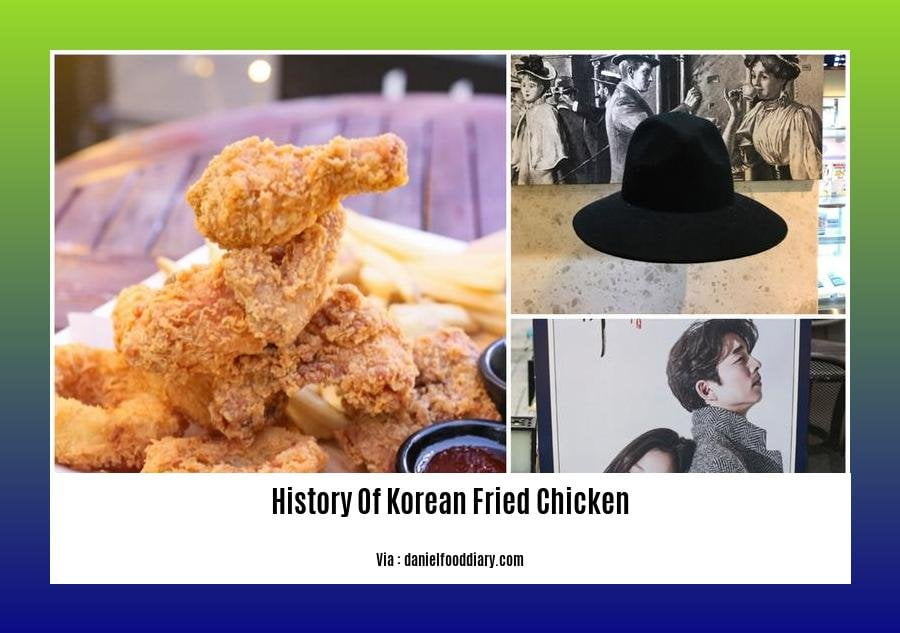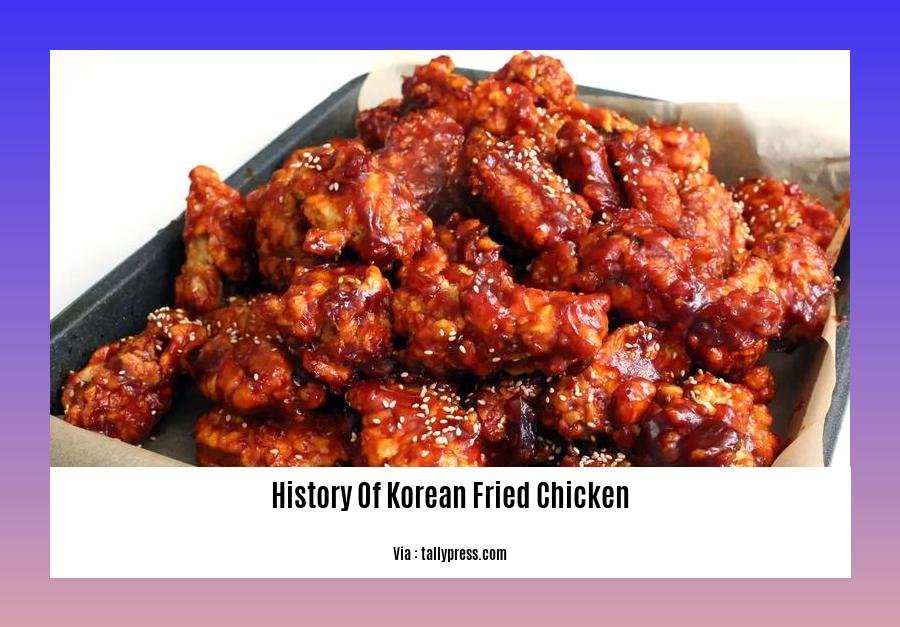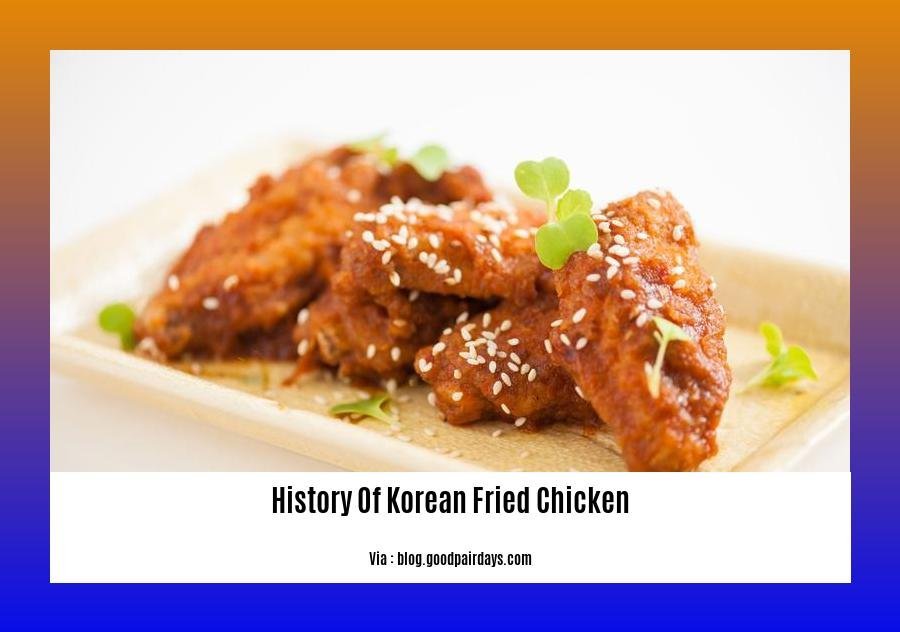Embark on a culinary journey through time as we explore the captivating history of Korean fried chicken, a dish that has tantalized taste buds and captivated hearts worldwide. From its humble beginnings as a street food to its current status as a global phenomenon, this beloved dish has undergone a remarkable transformation, leaving an indelible mark on the culinary landscape of Korea and beyond. Join us as we delve into the rich history and evolution of Korean fried chicken, uncovering the secrets behind its irresistible flavor and exploring its cultural significance in South Korea’s vibrant food scene.
Key Takeaways:
- Korean fried chicken, often called chikin, is a beloved dish in South Korea.
- Origins of the chicken frying recipe can be traced to the 15th century.
- In early Joseon, fried chicken was seasoned with vinegar, soy sauce, and called Pogye.
- Various sauces are utilized in Korean fried chicken, including soy garlic, spicy, and honey butter.
- Notable Korean fried chicken brands include bb.q Chicken, KyoChon Chicken, and Goobne Chicken.
- The popularity of Korean fried chicken has spread beyond South Korea, reaching countries like China, Japan, and the United States.
- Chimaek, a combination of Korean fried chicken and beer, is a famous and favored pairing.
- The Korean War introduced fried chicken to South Korea through American soldiers.
- Rapid growth of the Korean fried chicken industry occurred in the 1980s and 1990s, becoming a major part of the South Korean economy.
- Korean fried chicken is enjoyed by both locals and tourists, making it a national dish of South Korea.
- Constant innovation and introduction of new flavors and concepts are expected in the future of Korean fried chicken.
- Korean fried chicken symbolizes South Korean culture and is enjoyed by people of all ages.
History of Korean Fried Chicken

Korean fried chicken, fondly known as chikin, has taken the culinary world by storm, captivating global palates with its captivating flavors and crispy, golden-brown exterior. But behind this beloved dish lies a rich and fascinating history, deeply rooted in Korean culinary traditions and global influences.
An Origin steeped in Tradition:
Korean fried chicken can trace its origins back to the 15th century during the Goryeo dynasty. This cooking technique was initially employed to prepare royal court dishes, featuring chicken marinated in a mixture of vinegar and soy sauce, then fried to perfection. This dish, known as “Pogye,” laid the foundation for the contemporary Korean fried chicken we know and love.
An American Twist:
During the Korean War, American soldiers stationed in South Korea introduced their own fried chicken recipes, igniting a culinary fusion that would forever shape Korean cuisine. These American-style fried chicken dishes, characterized by their golden-brown crust and generous use of seasonings, quickly gained popularity among locals, leading to a surge in demand.
The Rise of a National Dish:
In the 1970s, Korean fried chicken began to emerge as a street food, with vendors popping up in bustling markets and along busy streets. These humble beginnings paved the way for the establishment of renowned Korean fried chicken chains, such as bb.q Chicken, KyoChon, and Goobne Chicken, which played a pivotal role in popularizing the dish both domestically and internationally.
Korean Fried Chicken Today:
Korean fried chicken has evolved into a culinary sensation, capturing the hearts of food enthusiasts worldwide. It has become an integral part of Korean cuisine, often served alongside a refreshing glass of beer, a pairing affectionately known as “chimaek.” The dish’s versatility allows for endless flavor combinations, ranging from the classic soy garlic sauce to the spicy and the sweet and savory honey butter sauce.
Cultural Significance:
Beyond its culinary appeal, Korean fried chicken holds cultural significance in South Korea. It has become a symbol of national pride, representing the country’s vibrant culinary heritage. The dish is frequently featured in Korean dramas and variety shows, further solidifying its iconic status.
A Journey of Innovation:
The Korean fried chicken industry continues to innovate, constantly pushing boundaries with new and creative flavor combinations. From the ultra-spicy “fire chicken” to the cheesy “snowing chicken,” there is always something new to satisfy adventurous taste buds.
A Global Phenomenon:
Korean fried chicken has transcended national borders, captivating palates across the globe. Its popularity has spread to neighboring countries like China and Japan and has made significant inroads into the United States and Europe. The global recognition of Korean fried chicken is a testament to its universal appeal.
Conclusion:
The history of Korean fried chicken is a journey of culinary evolution, blending traditional Korean cooking techniques with global influences to create a dish that has become a national treasure and a global culinary sensation. From its humble origins in the royal court to its current status as a global phenomenon, Korean fried chicken continues to captivate taste buds worldwide, embodying the vibrant spirit of Korean cuisine.
Ever wondered about the history of Japanese food culture? Delve into the fascinating evolution of Japanese cuisine and its global impact right here: history of japanese food culture.
And for those who love Korean barbecue, discover the rich history and traditions behind this mouthwatering culinary delight, from its origins to its modern-day popularity, in this comprehensive article: history of korean bbq.
Spreading Wings: The Globalization of Korean Fried Chicken and its Influence on International Cuisine

From humble origins as American-style fried chicken during the Korean War to a global culinary sensation, Korean fried chicken has captured hearts worldwide with its crispy, juicy goodness and unique blend of flavors.
Have you ever wondered what makes Korean fried chicken so special? Let’s delve into the history and evolution of this beloved dish, tracing its journey from the streets of Seoul to kitchens across the world.
The Korean Wave: A Culinary Symphony
The rise of Korean fried chicken is intricately linked to the “Korean wave,” or Hallyu, a global phenomenon that has seen Korean pop culture, including K-pop music and K-dramas, sweep the world. This cultural wave has sparked an unprecedented interest in Korean cuisine, with fried chicken emerging as a culinary ambassador of South Korea’s rich and vibrant gastronomic heritage.
Crispy on the Outside, Juicy on the Inside
What truly sets Korean fried chicken apart is its unique preparation method. The double-frying technique employed by Korean chefs results in an irresistibly crispy exterior while maintaining a tender and juicy interior. The chicken is first coated in a flavorful batter and fried at a relatively low temperature to ensure even cooking. It’s then cooled down before being fried again at a higher temperature, creating that signature crispy crust.
The Secret Sauce: A Symphony of Flavors
Korean fried chicken is synonymous with its distinctive sauce, a tantalizing blend of sweet, spicy, and savory flavors. The most popular sauce is undoubtedly the gochujang-based sauce, made with Korean chili paste, which imparts a vibrant red color and a delightful kick. Other popular variations include soy garlic, honey butter, and a whole spectrum of flavors that cater to diverse palates.
A Culinary Journey Beyond Borders
The globalization of Korean fried chicken is a testament to its universal appeal. From modest beginnings as a street food in Seoul to a culinary phenomenon that has spread across continents, Korean fried chicken has become a symbol of South Korea’s culinary prowess. Renowned Korean fried chicken chains like bb.q Chicken, KyoChon, and Bonchon have established a global presence, captivating taste buds worldwide with their signature recipes and authentic Korean flavors.
Key Takeaways:
Korean fried chicken’s popularity is attributed to the “Korean wave,” which has sparked global interest in Korean culture and cuisine.
The unique double-frying technique results in a crispy exterior and juicy interior, setting Korean fried chicken apart from other fried chicken variations.
The sweet, spicy, and savory sauce, often made with gochujang, is a defining characteristic of Korean fried chicken.
The globalization of Korean fried chicken is evident in the establishment of renowned Korean fried chicken chains worldwide, showcasing the dish’s universal appeal.
Korean fried chicken has influenced international cuisine, inspiring fusion dishes and variations that blend Korean flavors with other culinary traditions.
Sources:
Secret Ingredient: The Unique Flavors and Techniques that Set Korean Fried Chicken Apart
Crispy on the outside, juicy on the inside, and packed with flavor – Korean fried chicken, or “chimaek,” is a culinary masterpiece that has captured the hearts of food enthusiasts worldwide. Its unique combination of textures and flavors sets it apart from any other fried chicken you’ve tasted. Let’s dive into the secret ingredients and techniques that make this dish so irresistible.
Distinctive Double-Frying Technique
The secret to Korean fried chicken’s crispy exterior lies in its double-frying technique. The chicken is first coated in a flavorful marinade, then fried at a relatively low temperature to cook it through without overcooking. Next, it takes a second dip in the fryer at a higher temperature, resulting in a golden-brown, ultra-crispy crust that shatters with every bite.
Mouthwatering Marinade
The marinade is where the magic begins. Korean fried chicken is typically marinated in a blend of soy sauce, garlic, ginger, and sesame oil. This flavorful concoction infuses the chicken with a savory, umami-rich taste that perfectly complements the crispy exterior. Some variations may include additional ingredients like gochujang (Korean chili paste) or gochugaru (Korean chili powder) for a spicy kick.
Irresistible Sauce
No Korean fried chicken experience is complete without the dipping sauce. The most popular choice is yangnyeom sauce, a sweet and spicy sauce made with gochujang, gochugaru, garlic, ginger, and other spices. The sauce adds an extra layer of flavor and heat, making each bite a burst of taste sensations. Other popular sauces include soy garlic sauce, honey butter sauce, and cheese sauce, each offering a unique twist to the classic dish.
Diverse Side Dishes
Korean fried chicken is often served with a variety of side dishes, each adding its own unique flavor and texture to the meal. Pickled radish, kimchi, and rice cakes are some of the most common accompaniments. These side dishes not only provide a refreshing contrast to the richness of the chicken but also enhance the overall dining experience.
Key Takeaways:
- Korean fried chicken is renowned for its crispy exterior and juicy interior, achieved through a unique double-frying technique.
- The flavorful marinade, typically made with soy sauce, garlic, ginger, and sesame oil, infuses the chicken with umami-rich taste.
- The dipping sauce, particularly yangnyeom sauce, adds an extra layer of flavor and heat, making each bite a burst of taste sensations.
- Korean fried chicken is often served with a variety of side dishes, such as pickled radish, kimchi, and rice cakes, which enhance the overall dining experience.
- The dish has gained immense popularity worldwide, becoming a symbol of Korean cuisine and culture.
Additional Notes:
- Korean fried chicken is a versatile dish that can be enjoyed on its own, as a snack, or as part of a larger meal.
- The level of spiciness can vary depending on the sauce used, allowing diners to choose a flavor profile that suits their taste preferences.
- Korean fried chicken is a popular street food in South Korea and is often paired with beer, creating the iconic combination known as “chimaek.”
- Many Korean fried chicken restaurants offer a variety of unique flavors and toppings, such as cheese-coated chicken, spicy garlic chicken, and honey butter chicken.
Sources:
– Korean Fried Chicken: The Ultimate Guide
– Korean Fried Chicken: A Crispy, Savory Delight
KFC or Korean Fried Chicken: The Distinctive Qualities that Differentiate the Two Styles
KFC (or Korean Fried Chicken), loved by many worldwide, is an exquisite dish with a unique story and flavor profile that sets it apart from its American counterpart. Get ready to embark on a culinary journey as we delve into the distinctive qualities that make Korean fried chicken a truly remarkable culinary experience.
Key Takeaways:
- KFC utilizes a double-frying technique, giving it a uniquely crispy exterior and tender, juicy interior.
- KFC’s marinade often incorporates soy sauce, garlic, ginger, and other spices, infusing it with a savory and slightly sweet flavor.
- KFC is traditionally paired with a variety of dipping sauces, adding extra layers of flavor and richness.
- In Korea, KFC is a popular street food and is often served with beer, a combination known as “chimaek.”
- KFC has become a global sensation, with restaurants popping up in countries worldwide, showcasing the dish’s international appeal.
Origins of KFC: A Fusion of Influences
The history of Korean fried chicken is a fascinating tale of culinary fusion. It’s believed that during the Korean War, American soldiers introduced their fried chicken recipes to the locals. These recipes were then adapted and combined with Korean cooking techniques and flavors, resulting in the birth of KFC.
What Makes KFC Different? Exploring Its Unique Characteristics
Frying Technique: KFC’s double-frying method sets it apart. The chicken is first fried at a lower temperature to cook the meat, then fried again at a higher temperature to achieve a crispy, golden-brown exterior.
Marinade: KFC is typically marinated in a flavorful blend of ingredients like soy sauce, garlic, ginger, and other spices. This marinade infuses the chicken with a savory and slightly sweet taste that’s uniquely Korean.
Dipping Sauces: KFC is often served with a variety of dipping sauces, each offering a distinct flavor experience. Popular sauces include soy sauce, garlic sauce, and gochujang sauce, adding an extra layer of richness to the dish.
Cultural Significance: KFC holds a special place in Korean culture. It’s a beloved street food, often enjoyed as an accompaniment to beer in a combination known as “chimaek.” KFC also features prominently in Korean dramas and variety shows, reflecting its deep-rooted connection to Korean culinary identity.
KFC’s Global Reach: A Culinary Ambassador of Korea
KFC’s popularity has transcended borders, becoming a global culinary sensation. Korean fried chicken restaurants can now be found in countries around the world, introducing international audiences to this delicious dish. From Seoul to New York, London to Sydney, KFC has captured hearts and taste buds everywhere, showcasing the global appeal of Korean cuisine.
The Future of KFC: Innovation and Expansion
KFC continues to evolve and innovate, with new flavor combinations and cooking techniques emerging all the time. From ultra-spicy “fire chicken” to cheesy “snowing chicken,” KFC’s culinary creativity knows no bounds. As KFC’s popularity continues to soar, it’s poised to remain a beloved dish worldwide, representing the vibrant and ever-evolving landscape of Korean cuisine.
[Source 1: https://www.tastingtable.com/1061129/what-makes-korean-fried-chicken-so-unique-according-to-emily-maangchi-kim-exclusive]
[Source 2:
FAQ
Q1: What are the origins of Korean fried chicken?
A1: The history of Korean fried chicken can be traced back to the 15th century during the Goryeo dynasty when a recipe for frying chicken was developed. In the early Joseon dynasty, this dish was seasoned with vinegar and soy sauce and called “Pogye.”
Q2: What makes Korean fried chicken unique?
A2: Korean fried chicken is unique due to its double-frying technique, which results in a crispy exterior and juicy interior. The use of a sweet and spicy sauce, often made with gochujang (Korean chili paste), is another defining characteristic.
Q3: How did Korean fried chicken gain popularity worldwide?
A3: The popularity of Korean fried chicken can be attributed to the Hallyu or “Korean wave” of K-pop music and K-dramas, which has increased global interest in Korean culture and cuisine. The dish has become a symbol of South Korea’s culinary identity and has gained popularity in many countries worldwide.
Q4: What are some popular Korean fried chicken brands?
A4: Some popular Korean fried chicken brands include bb.q Chicken, KyoChon Chicken, and Goobne Chicken. These brands have contributed to the growth and success of the Korean fried chicken industry both in South Korea and internationally.
Q5: How is Korean fried chicken typically served?
A5: Korean fried chicken is often served with a variety of side dishes, such as pickled radish, kimchi, and rice cakes. It is also commonly paired with beer, a combination known as “chimaek.”
















